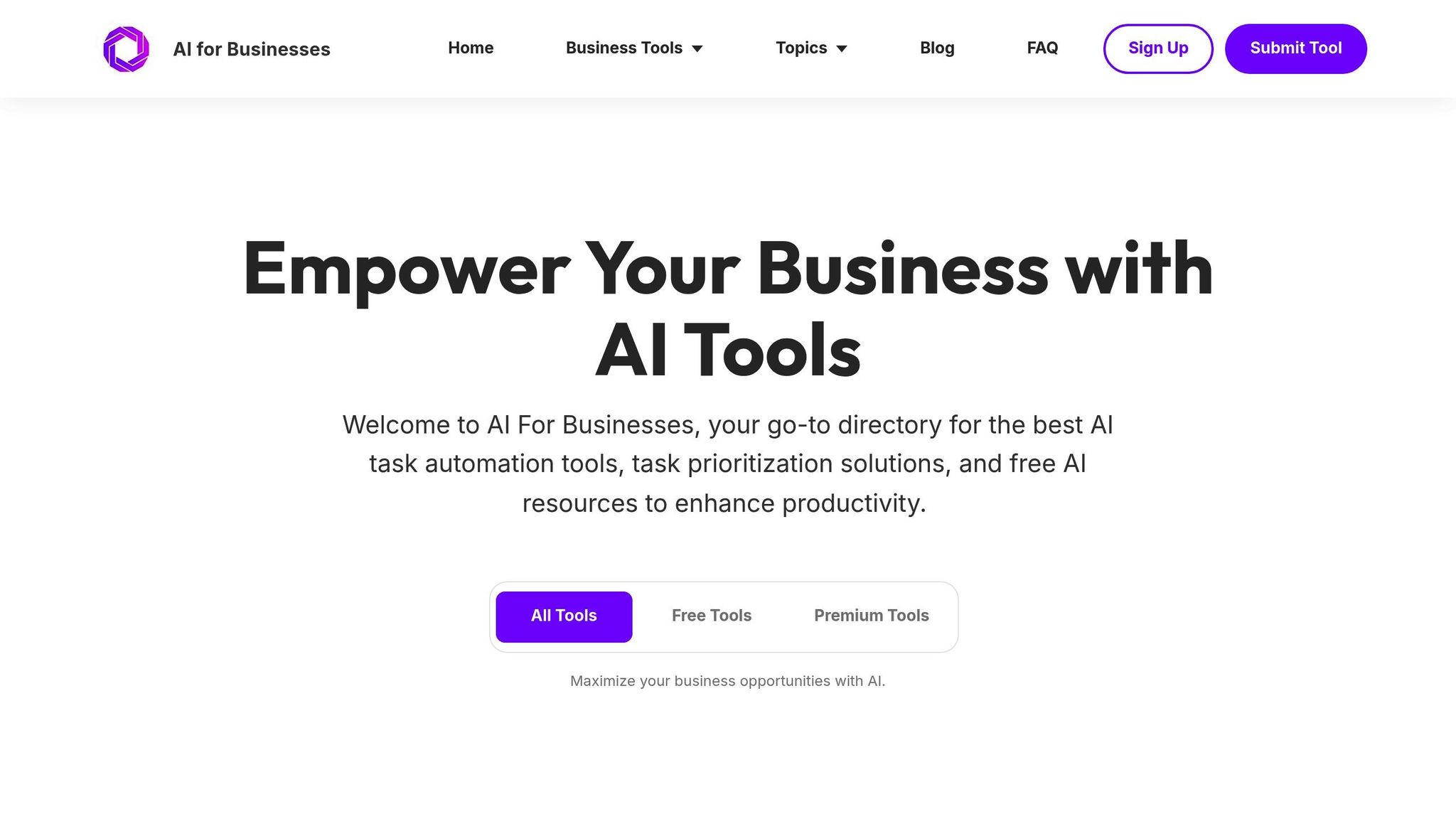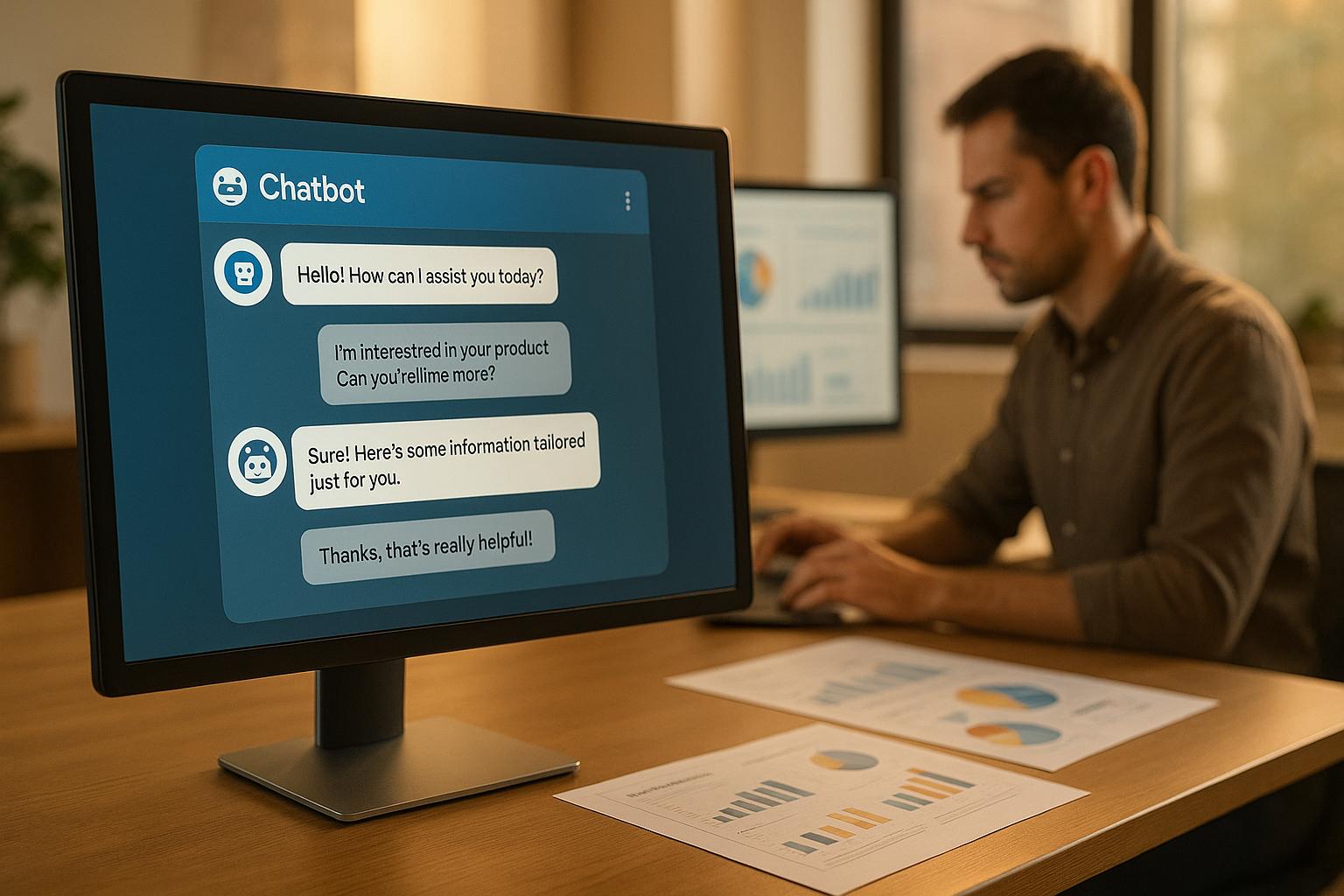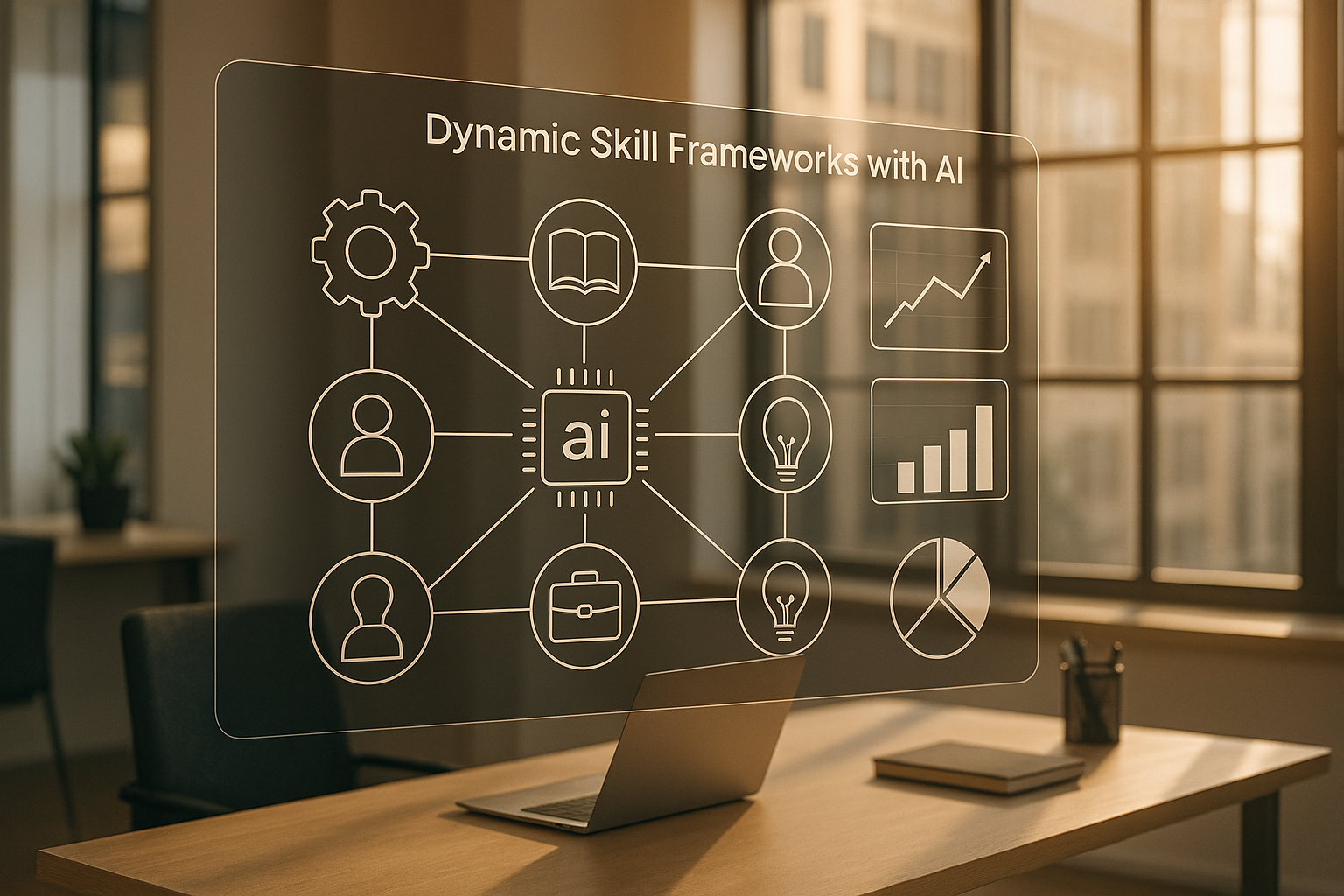AI tools are changing how businesses measure employee engagement. Instead of relying on outdated surveys, these tools provide real-time insights, helping managers make informed decisions to improve satisfaction and retention. They analyze key metrics like employee loyalty, sentiment trends, and turnover risks, offering actionable data to address issues before they escalate. Here's what you need to know:
- Employee Net Promoter Score (eNPS): Quick surveys reveal employee loyalty and identify departments needing attention.
- Sentiment Analysis: AI evaluates written feedback to detect emotions and spot concerns like workload or communication problems.
- Turnover Predictions: Advanced analytics highlight employees at risk of leaving, enabling timely interventions.
To get started, define your goals, choose a tool that integrates with your systems, and use its insights to drive targeted improvements. Prioritize data privacy to maintain trust and ensure compliance. AI tools not only provide faster insights but also help build stronger, more engaged teams.
AI and Employee Engagement: Measuring What Really Matters
Key Metrics AI Tools Track for Employee Engagement
AI tools zero in on critical metrics like loyalty, sentiment, and future behavior to offer a clearer picture of employee engagement. These indicators go beyond surface-level satisfaction, helping U.S. businesses hold onto top talent and build resilient teams. By identifying and analyzing these metrics, companies can take meaningful steps to improve employee satisfaction. Let’s explore the primary metrics AI tools monitor to measure engagement.
Employee Net Promoter Score (eNPS)
The Employee Net Promoter Score (eNPS) adapts a popular customer satisfaction metric for workplace use, asking one straightforward but telling question: "How likely are you to recommend this company as a place to work?" Employees respond on a scale of 0 to 10, and their answers are grouped into three categories: promoters (9–10), passives (7–8), and detractors (0–6).
eNPS is prized for its ability to predict employee loyalty. High scores suggest strong commitment, while low scores can signal potential turnover risks. AI tools shine in tracking eNPS trends over time, revealing which departments or managers are fostering engagement and where improvements are needed. Since the survey is brief, it typically gets higher response rates compared to longer questionnaires. AI systems also automate survey timing to maximize participation and even analyze the emotional tone behind the feedback, giving companies a deeper understanding of employee sentiment.
Sentiment Analysis and Feedback Trends
AI tools go beyond numbers by analyzing written feedback from surveys, reviews, internal chats, and suggestion boxes. They use context and tone to identify emotional patterns and track sentiment trends, offering a more nuanced view of engagement.
For instance, an employee might report high job satisfaction overall but express concerns about workload or communication in open-ended responses. Sentiment analysis captures these subtleties, helping managers address specific concerns that numerical scores might miss. By monitoring sentiment over time, companies can evaluate the effectiveness of engagement initiatives and spot recurring themes, like struggles with work-life balance or communication gaps. AI systems can even flag emerging negative sentiment in real time, allowing for immediate action to prevent issues from escalating. These insights provide a foundation for understanding retention risks, which brings us to the next key metric.
Retention and Turnover Predictions
One standout feature of AI engagement tools is their ability to predict which employees might be at risk of leaving. By analyzing engagement data alongside performance metrics, communication patterns, and behavioral shifts - such as reduced meeting participation or changes in tone - AI tools can identify warning signs early.
This predictive power allows companies to step in with targeted retention strategies, addressing concerns before they lead to resignations. Additionally, by uncovering trends in why employees leave, AI tools help organizations pinpoint underlying issues, such as weak management practices or lackluster engagement efforts. These insights guide companies toward making adjustments that can curb future turnover and strengthen overall employee satisfaction.
Step-by-Step Guide to Using AI Tools for Employee Engagement
Small and medium-sized enterprises can achieve meaningful results with AI tools by taking a thoughtful and systematic approach. Success starts with aligning the tools to your company’s unique needs and resources.
Assess Business Needs and Define Engagement Goals
Start by evaluating your current employee engagement landscape. Gather input from employees, HR teams, and managers to uncover specific challenges. Are certain departments experiencing high turnover? Do employees feel disconnected from company goals? Are there communication gaps between management and staff? Identifying these pain points will help you focus your efforts.
Next, set clear and measurable objectives for what you want the AI tool to accomplish. Whether it’s reducing turnover rates or increasing participation in company initiatives, having specific targets will guide your tool selection and help measure its effectiveness.
Also, take a close look at how you currently measure engagement. If you’re relying on annual surveys or informal feedback, there’s likely room for improvement. AI tools can provide real-time insights and predictive analytics, offering a more dynamic picture of employee sentiment. Document these gaps to ensure you prioritize features that address your most pressing needs.
Select and Set Up the Right AI Tool
Once your goals are clear, it’s time to choose a tool that aligns with them. Look for features that directly address your objectives, such as real-time feedback, pulse surveys, predictive analytics for turnover risks, and sentiment analysis. These capabilities can provide a comprehensive view of engagement across your organization.
Integration is key. Your AI tool should work seamlessly with existing systems like your HRIS, performance management platforms, and communication tools such as Slack or Microsoft Teams. This reduces manual data entry and ensures that engagement insights are easily accessible.
Don’t overlook user experience and mobile accessibility. A tool with an intuitive dashboard and mobile-friendly design will encourage employees to participate, making it easier for them to complete surveys and share feedback.
Scalability is another factor to consider. Choose a tool that can grow with your business and offers flexible pricing options to accommodate future needs.
Finally, prioritize data privacy and security. Make sure the tool complies with regulations like GDPR or CCPA, uses data encryption, and supports employee anonymity when needed. Trust is essential for gathering honest feedback, so employees need to feel confident their data is secure.
Analyze and Act on AI-Generated Insights
Once your AI tool is set up, use its dashboard to transform data into actionable strategies. AI tools often provide visualizations that make it easier to identify trends. Look for patterns across time periods, departments, and employee demographics to pinpoint areas needing attention.
Focus on practical insights. For example, if sentiment analysis reveals frustration in a specific department due to unclear expectations, this indicates a need for improved communication or targeted management training. Similarly, if turnover predictions highlight risks in certain areas, take steps to understand and address those concerns before they escalate.
Share findings with leadership and managers through regular reports that highlight key trends and actionable recommendations. For instance, if eNPS scores are dropping in a particular team, you might suggest manager coaching or redistributing workloads to address the issue.
Act quickly on these insights. Start with small, targeted interventions and use the AI tool’s feedback capabilities to monitor their impact. Once you’ve confirmed what works, expand these strategies across the organization. While AI tools are excellent for identifying patterns and predicting trends, human judgment is critical for understanding the context and making thoughtful decisions. This combination ensures ongoing improvements in employee engagement.
sbb-itb-bec6a7e
Popular AI Tools for Measuring Employee Engagement
When it comes to improving employee engagement, AI tools can be a game-changer. But with so many options out there, figuring out which tool fits your needs can feel overwhelming. That’s where resources like the AI for Businesses directory come in handy, offering a curated list of AI tools tailored for small and medium-sized enterprises (SMEs) and growing companies.
AI for Businesses: Your Go-To Directory for Engagement Tools

This directory simplifies the process by categorizing AI tools based on specific business functions. Whether you’re looking to track engagement levels or implement strategies to enhance them, it’s designed to help you find the right solution quickly and efficiently.
Here’s a breakdown of the pricing options available:
- Basic: Free access, providing limited information about tools.
- Pro: $29/month, offering full access to the directory and priority customer support.
- Enterprise: Custom pricing for businesses needing tailored solutions and dedicated support.
With these clear pricing tiers, organizations of all sizes can explore tools that meet their engagement goals without the hassle of endless searching.
Best Practices for Using AI Tools to Improve Engagement
To get the most out of AI tools for engagement, it's crucial to present, integrate, and safeguard their insights thoughtfully. When paired with proper measurement and setup, these practices ensure AI-driven insights lead to meaningful and ongoing improvements.
Use Data Visualizations for Better Decision-Making
Raw data from AI can feel overwhelming, but visual dashboards simplify it into clear, actionable insights that are easy for leadership to grasp.
For example, AI platforms often include heatmaps that reveal engagement levels across departments, teams, or specific time periods. These visual tools make it easy to identify patterns that might otherwise go unnoticed in spreadsheets. You might spot, for instance, a recurring dip in engagement on certain days or a spike after team meetings.
Interactive charts take this further by allowing you to drill down into specific data points, like identifying key comments that shape employee sentiment. This added context enables managers to act quickly and make informed decisions about team interventions.
The most effective visualizations focus on trends rather than isolated data points. A dashboard showing engagement trends over several months tells a far richer story than a one-day snapshot. Look for tools that automatically flag significant changes or anomalies, saving you time on manual analysis.
Integrate Engagement Insights into Business Strategy
Once you have clear visual data, the next step is to tie these insights directly to your business goals. Engagement metrics become far more impactful when they’re linked to measurable outcomes rather than treated as standalone HR statistics.
For instance, if your AI tool shows that highly engaged teams consistently deliver better customer satisfaction, you can use that connection to justify investments in engagement strategies. This shifts engagement metrics from being a “nice-to-have” to a key driver of business performance.
To make this work, incorporate AI insights into performance management systems. Use the data to guide manager training and evaluate leadership effectiveness. If AI flags signs of employee disengagement, prompt leaders to take immediate action.
Regular strategy sessions are essential to keep engagement insights front and center. Schedule routine reviews where department heads discuss how AI-identified trends relate to productivity, retention, and achieving company goals. This creates accountability and ensures the data is actively shaping decisions.
It’s also crucial to make engagement insights accessible to non-HR stakeholders. When operations managers see how engagement impacts metrics like product quality or sales conversion rates, it fosters organization-wide commitment to improvement.
Maintain Data Privacy and Compliance
Since engagement data often includes sensitive information, handling it responsibly is critical to maintaining trust and staying compliant with U.S. employment laws.
Start by being transparent with employees about what data is being collected and why. Limit detailed access to HR and senior leadership, and implement automated data retention policies to safeguard privacy. Regular legal reviews and audits of access controls can help mitigate compliance risks.
Access to engagement data should be carefully managed. Department heads may need team-level insights, but individual responses should remain restricted to HR and top leadership. Conducting periodic audits ensures these controls stay effective as your organization grows.
Conclusion: Transform Employee Engagement with AI Tools
AI tools are reshaping how businesses in the U.S. approach employee engagement. Gone are the days of relying solely on outdated annual surveys. Today, companies can tap into real-time insights that uncover engagement trends as they happen.
By focusing on critical metrics like Employee Net Promoter Score (eNPS), sentiment analysis, and turnover predictions, organizations can go beyond just collecting data. These tools help pinpoint patterns and address potential issues before they escalate into bigger challenges that affect productivity.
For small and mid-sized businesses, as well as growing companies, engagement data plays a direct role in driving outcomes that matter - like boosting revenue. Teams with higher engagement levels are known to deliver exceptional customer service, hit deadlines more consistently, and contribute fresh ideas to innovation efforts.
The real game changer? Selecting tools that align with your unique business goals, using clear visualizations to present findings, and weaving these insights into your broader strategy. And let’s not overlook the importance of prioritizing data privacy and compliance to maintain employee trust.
With AI, businesses can make faster, more informed decisions, creating workplaces where employees feel genuinely valued. For those ready to take the plunge, these tools offer the precision and clarity needed to build stronger, more engaged teams.
FAQs
How do AI tools provide more accurate insights into employee engagement than traditional surveys?
AI tools bring a sharper edge to understanding employee engagement by leveraging real-time data analysis, sentiment analysis, and predictive algorithms. Traditional surveys often fall short due to biases or low participation rates. In contrast, AI dives into ongoing workplace interactions and communications, offering a more genuine look at engagement levels.
With these tools, businesses can uncover trends like potential turnover risks or pinpoint areas needing attention - quickly and with precision. By keeping a finger on the pulse of engagement, organizations can make data-backed decisions to boost both employee satisfaction and productivity.
What steps can businesses take to protect employee data and stay compliant when using AI tools for engagement?
To safeguard employee data and ensure compliance, businesses need to focus on data privacy and responsible AI practices. Start by being upfront with employees about the data you collect, how it’s used, and why it’s necessary. Use secure AI tools designed to protect sensitive information, and routinely check algorithms for potential biases to ensure fairness.
It’s also crucial to stay informed about federal and state regulations, such as GDPR and CCPA, and provide regular training to employees on data protection and privacy best practices. By setting clear accountability measures and consistently monitoring for security vulnerabilities, companies can promote responsible AI use and build trust within their teams.
How can small and medium-sized businesses use AI insights to improve their overall strategy?
Small and medium-sized businesses (SMBs) have a great opportunity to refine their strategies by leveraging AI tools tailored to their goals - whether that's increasing efficiency, enhancing customer interactions, or anticipating market shifts. The first step? Pinpoint areas where AI can genuinely make a difference, like automating time-consuming tasks or extracting meaningful insights from massive amounts of data.
Getting your team on board early is key. Offer training to ensure everyone knows how to use these tools effectively. Start small by testing user-friendly AI solutions, and then measure their impact to determine what works best for your business. When used thoughtfully, AI can help SMBs make smarter choices, stay ahead of the competition, and fuel long-term growth.


